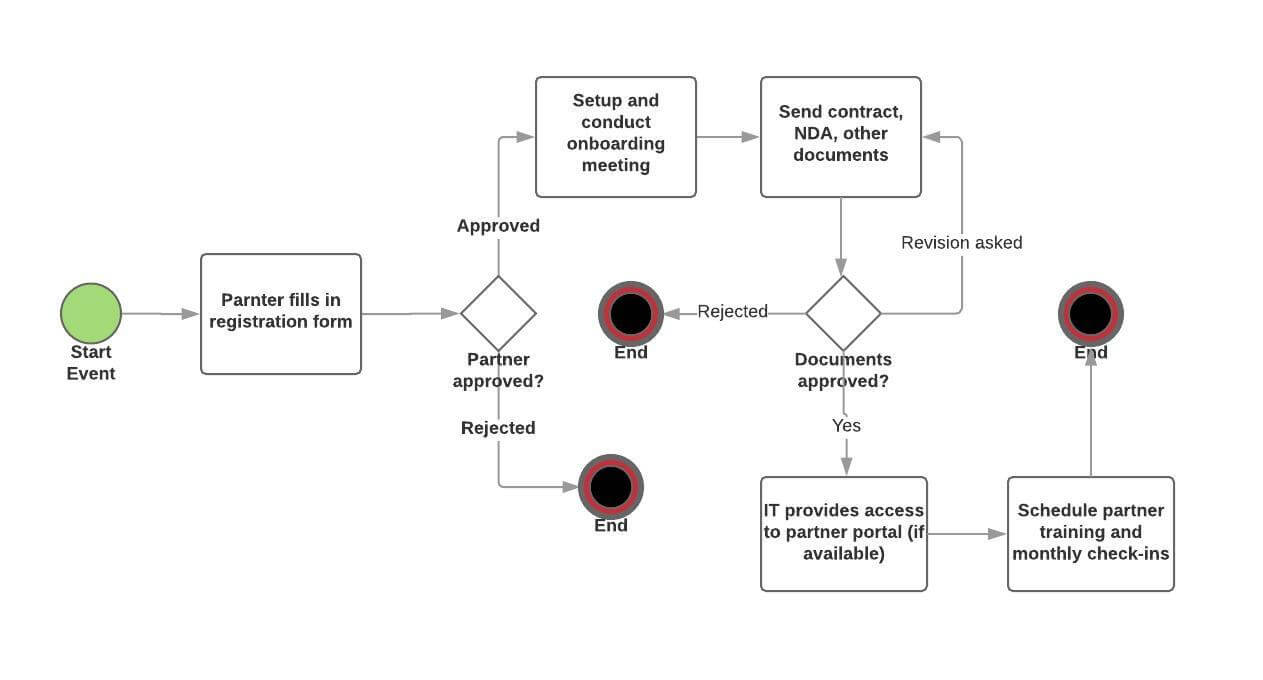The “to-be business process” is the future state of an as-is process. If, after document and analyzing an as-is process, you realize that there are potential improvements to be made, you create a to-be process map as a means of visualizing the aforementioned improvements.
How to Document a To-Be Business Process
Before documenting the to-be business process, you should already have an as-is process document at hand. You need to already know how the process works before you can actually improve it and create the to-be business process document. If you don’t have the as-is process documented and analyzed, you can learn how to do it with our guide.
Once you know what potential improvements you can make to the process, you can start mapping the to-be business process.
This is pretty straightforward – you create a process flowchart, i.e you draw the exact steps you’d need to take to complete the process. So for example…

You do this with one of the following ways:
- Pen & Paper – The easiest option is to just grab a piece of paper and draw the process flowchart.
- Flowchart Software – Software used for creating process maps. The upside of using software for this is being able to share your charts with employees digitally.
- Workflow Management Software – Software used for creating, managing and tracking processes.
Once you have the documentation at hand, you can send it out to your employees and let them know that you’re making changes to the as-is process and that you’ll be doing things differently from that point on.
How to Implement a To-Be Business Process
Documenting the to-be business process is just the first step. It allows you to get a glimpse of how the new process will work, but the process won’t implement itself. You need to use the to-be process as a guide for implementing it in the workplace.
The implementation, in general, is a bit tricky, as it really depends on what processes you’re working on. Generally, though, there are some best practices we try to follow…
Pick the Right Metrics – While the new process might work better than the old in theory, the same might not hold true in practice. You’ll need to pick the metrics from the old process. Once you implement the changes, you’ll simply benchmark the new metrics to the old ones.
Account for Potential Risks – Sometimes, your improvements might only be a short-term solution. If, for example, you manage to increase manufacturing output. This might seem like a positive change for a while, but then you realize this also leads to a higher defect rate, which brings you back to square one. By accounting for such situations, you’ll avoid a lot of headache for the future.
Start Small and Scale Up – You can never be 100% sure that your changes are going to end up being positive. It’s always a good idea to start small with the process. Think, for one specific team or one manufacturing line, rather than department or site-wide.
Enforce the New Process – People rarely like change. Even if it’s something that makes their jobs easier, they might still end up forgetting to follow through with it in a week. You’ll need to actually make sure that the changes you made are enforced. To do this, you can either manually check on the employees, or use workflow management software to enforce the changes.
Post-Implementation: Keeping Track
Once you get to this stage, you might think you’re already done with the job. You pet yourself on the back and call it a day.
Sadly, however, that’s not exactly how process management works. After implementing the new process, you need to make sure that it’s working as you predicted. Meaning, you’ll need to benchmark the new process to the KPIs and if something goes wrong, roll back to the older process.
To make process improvement and management significantly easier, you could employ workflow management software. It can help with enforcing new processes, increasing productivity, as well as measuring your process metrics.

